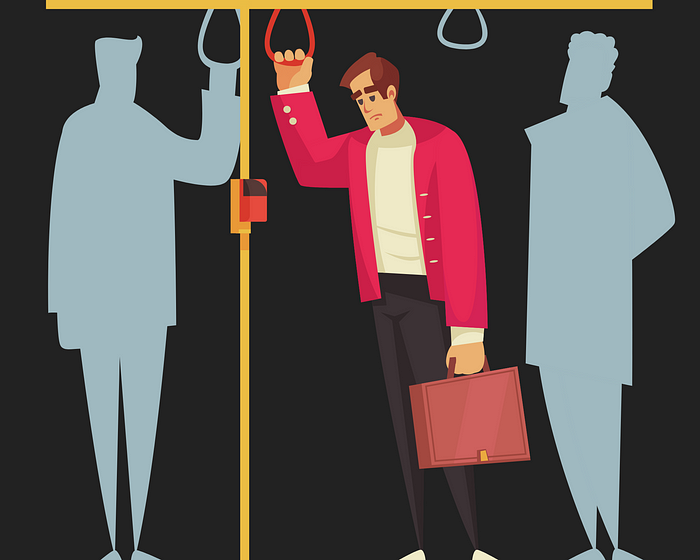Burnout and Loneliness: Workplace Problems, Not Worker Problems
Organizational psychologist Constance Noonan Hadley shares tips for recognizing, addressing, and avoiding workplace burnout and loneliness.
By Constance Noonan Hadley and Thalia Plata

Sick and tired of your nine-to-five, or is your nine-to-five literally making you sick and tired? If you answered yes to either question, you are not alone. According to Willis Towers Watson’s 2022 Global Benefits Attitudes Survey, 44% of surveyed employees are actively seeking new jobs or are planning to start.
But what is driving this mass exodus commonly referred to as the Great Resignation? Dr. Constance Noonan Hadley, an organizational psychologist and lecturer in the Management and Organizations Department at Boston University’s Questrom School of Business, believes the answer could lie in the midst of workplace culture: “Loneliness and burnout — both before and during the COVID-19 pandemic — are key drivers of the Great Resignation, or Great Rethinking, as I like to call it.”
Hadley points to a new study that surveyed 31,000 people across 31 countries, revealing that 55% of hybrid employees and 50% of all-remote employees reported feeling lonelier at work than before the pandemic. “The evidence is there that people are tired of feeling disconnected and burned out, and they are seeking a more balanced and health-forward work situation,” says Hadley.
While the numbers are startling, working on improving employee satisfaction is not a lost cause. We asked Hadley to share research-based techniques to identify workplace burnout and loneliness — and ways to address these issues from both an individual and business standpoint. Hadley also shares actionable advice for employers and individuals to put in place to prevent burnout and loneliness from occurring in the workplace. See below for the full Q&A.
How do you define workplace burnout and loneliness?

In my research and teaching, people often tell me “I’m so burned out!” but when I probe further, I find that they are not experiencing the full syndrome. “Burnout” involves three distinct symptoms: energy depletion and exhaustion, depersonalization and cynicism, and reduced efficacy.
Workplace loneliness is more straightforward than burnout, although no less distressing. “Loneliness” is defined as having inadequate social relationships with others.
What do these experiences look like and how can professionals identify if they are experiencing them?
Let’s start with recognizing burnout. Understanding the following symptoms can help professionals identify burnout in themselves.
Burnout Symptoms
Energy Depletion and Exhaustion
We have all had those days when it is hard to get out of bed in the morning and get started on work. We also know what it is like to push hard on a particular project and look forward to a few days off to recuperate. But the kind of exhaustion associated with burnout is more chronic and nonspecific. It doesn’t go away after a vacation, and it is not tied to a particular project or deadline. It feels like a persistent fog weighing you down mentally and physically.
Depersonalization and Cynicism
In addition to that kind of debilitating exhaustion, burnout is associated with feeling detached and distanced from a job or even becoming cynical about it. Importantly, burnout is associated with a change in those sentiments. For example, perhaps you are a doctor and you used to find great joy in helping others but now you feel more numb, or less empathetic, toward your patients. You might even start to question whether anything you are doing is making a difference. In a business context, you might begin to feel disinterested in your work or start to question the motives and intentions of your company. Simply put, what used to motivate and inspire you about your job no longer has the same effect.
Reduced Efficacy
The third component of burnout is a drop in work performance. Perhaps you used to be great at your job and now you feel yourself slipping. It may not even be something that your boss or clients notice, but you know the difference in your work quality. Or you may be maintaining the same peak performance but at a greater cost: it now takes more work, more concentration, and more effort than before.
Burnout is defined by having all three of these symptoms at the same time. Otherwise, you might not be burned out — but you could still need to make some changes. For example, if you are experiencing persistent exhaustion, you might be suffering from overwork or overextension that requires cutting back your hours or responsibilities. Or, if you are feeling more cynical and distanced from your work, you might need to find ways to reinvigorate your job tasks or reaffirm your belief in your organization’s mission. If you’re experiencing a drop in performance but don’t have any of the other symptoms of burnout, think about what has changed in your approach to work. Identifying what is actually going on with you is the first step to figuring out what to do about it.
Loneliness Symptoms
In my research, people often say their coworkers are nice, but that they don’t really know them well. This has been especially true during the COVID-19 pandemic when so many professionals have only interacted with their colleagues virtually. Yet loneliness is more than a lack of in-person interaction with others.
Whether remote, hybrid or at the office, loneliness is a yearning for a deeper connection with others. Just because people are working doesn’t mean they stop being human — they still want to be noticed, cared about, and included. One question I like to ask in interviews is, “Who ‘has your back’ here? Who would be there for you if you needed help?” If they don’t have a clear and confident answer, there is a good chance the person is lonely.
How do workplace burnout and workplace loneliness intersect?

There is much that burnout and loneliness have in common. Both are associated with debilitating health effects. Loneliness has been shown to have the same effect on mortality as smoking 15 cigarettes a day. At work, these conditions reduce productivity as well. Research has shown that these conditions have dramatic negative effects on teams and organizations due to increased absenteeism, turnover, and healthcare costs. For example, Cigna estimated that loneliness cost U.S. employers over $400 billion a year, and this was before the COVID-19 pandemic. Burnout has also been shown to lead to depression and suicidal thoughts. We must take these issues seriously.
A second characteristic that burnout and loneliness share is that they were growing before the pandemic struck, which implies they will not go away magically when the pandemic ends. For example, Mark Mortensen and I surveyed global executives in December 2019 and January 2020. At that time, 76% of the executives reported that they had difficulty making connections with their work teammates, and 58% agreed with the statement “My social relationships are superficial at work.”
U.S. Surgeon General Vivek Murthy has also been concerned about this issue for a while, declaring a “workplace loneliness epidemic” in 2017. Burnout has similarly been an issue for a long time, particularly in occupations such as healthcare and law. The World Health Organization declared burnout an official occupational phenomenon in 2019.
What can employers do to acknowledge and prevent employee burnout and loneliness?

One more attribute that burnout and loneliness have in common is that they are often mistakenly treated at just the individual level. People are told to practice self-care or reach out to a friend or family member for support. While not bad advice per se, these steps are likely not enough. These are workplace problems, not worker problems. The environment is triggering these responses in employees.
There is much that senior leaders can do to address burnout and loneliness, starting with educating themselves about what is really going on with their workforce. Instead of generic culture or engagement surveys, companies should collect targeted data on these issues. This is not easy because loneliness, and to a lesser degree, burnout, are socially stigmatized. People are reluctant to admit these experiences for fear of being viewed as weak or dysfunctional.
In my research, I have created scales to reliably measure workplace loneliness, as well as incorporated measures validated by other researchers. Even with these tools, leaders will likely miss out on some of the nuances. I recommend conducting interviews and focus groups as a follow-up to any survey, led by trusted members of the organization or outside facilitators.
Once the baseline is known, leaders can work with employees to set clear targets and put an action plan in place to improve the work factors that are contributing to burnout and loneliness. It is critical to monitor these issues systematically and regularly — especially as work demands and arrangements continue to evolve. Ideally, leaders should be aware of the “early warning signals” before employees start walking out the door.
I advocate empowering teams to help implement the many changes that may need to take place. Teams have the potential to be not only a problem-solving and work-producing unit in organizations but also a people-supporting unit. This is true especially if some of the traps of poorly designed teams are avoided, as I wrote about in a MIT Sloan Management Review article with Mark Mortensen. A key component of that team support is to create a culture of psychological safety and empathy. In my Harvard Business Review article, I explain how some companies are doing this.
In general, a major step that leaders can do is to take the heat off employees from a workload standpoint. Our workdays have gotten longer with the move to remote work, and hybrid has the potential to extend them even further. We must carve out time for people to rediscover their intrinsic motivation at work by giving them opportunities to think and explore without crushing deadlines. The same goes for building social connections at work — as I explained in the 2022 Work Trend Index report, relationship-building is one of the first activities to get cut when people feel under the gun.
Another “must-do” is to reward people for doing the things that will make them healthy and engaged employees in the long run. Performance criteria can be modified to encourage inclusive environments and social networking. I am currently working on a research project with early findings showing that, in workplaces with rewards for supportive behaviors, employees report stronger work relationships and lower burnout.
I encourage leaders to lean into this moment when mental health and wellbeing are so top of mind for employees. Set up a variety of resources, both internal and external, to provide on-demand support for employees. For example, employee resource groups can help not only with inclusion but also with loneliness. To the degree possible, I also suggest that companies add or extend mental health benefits coverage to their employees.
Overall, I hope this information informs but also inspires managers and employees to work together to tackle burnout and loneliness. Ultimately, we all share the goal of having a thriving workforce, a goal the pandemic has only made clearer.
For additional commentary by Boston University experts, follow us on Twitter at @BUexperts. Follow Questrom School of Business on Twitter at @BUQuestrom.
